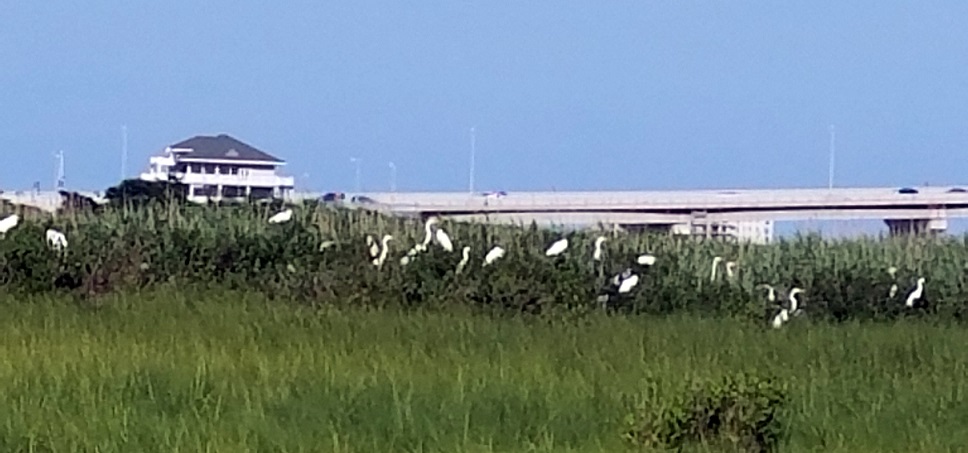
For most of us who vacation in Ocean City, there is that time of packing the clothes, the beach gear and chairs, taking care of all the last minute details and jumping in the car. We are on our way, vacation is here, we are headed to the shore. If you are traveling on the weekend, the excitement of it all is soon muddied a bit as we come to a stop on the congested roadways and wait our turn to get through the snarls of traffic. For those who are headed to Cape May County, the Somers Point area, exit 30 of the Garden State Parkway must bring to them a somewhat euphoric state. The coastal meadows which the parkway winds through, brings the feel that life is slowing down. The worries and details which were so important yesterday fade from our memory and the sense of recreation and relaxation floods the mind. The coastal estuaries and open spaces let us know that we are getting close and the excitement of vacation rebuilds in us. The children stop asking if we are there yet and a peace and serenity enters in as we cross the bridge onto the barrier islands. With all the business behind us, we settle in and think of the beach, the surf and the boardwalk. We may not think much of the bridge we crossed to be here until we leave, but as important as the sand, sun and water is to Ocean City, likewise, so is the bridge that bought us here.
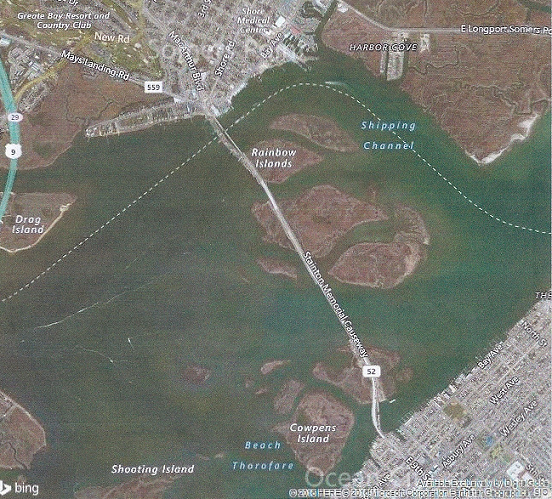
Today my wife and I have decided to explore the Howard S. Stainton Causeway, Route 52 and locally known as the Ninth Street Bridge. At first glance we may not realize the natural value of it, but turning our focus away from the concrete and traffic, we see a vast natural area within the back bay region which holds the habitat for all the different species of plant, fish, shellfish and wildlife that depend on it for feeding, nesting and life in general. Situated along the Atlantic Flyway, the bicycle and pedestrian walkway along the bridge offers us 2.2 miles one way of access and viewing of the Great Egg Harbor Bay. On the Somers Point end there is Ship’s Channel which connects the Atlantic Ocean to the Great Egg Harbor River, and leads 10 miles inland to Mays Landing. On the Ocean City end there is the Intracoastal Waterway which runs along the western side of Ocean City. Parking our car at the Visitors center, we grab our binoculars and climb the steps to the second floor deck which surrounds the building. Situated along the deck railings are numerous informational plaques which tell the history of the bridge, the various wildlife which visits the area, as well some of the history of early Ocean City. The history of the railroads which first brought tourists to the shore along with the beginning of automobile traffic across the first wooden timber bridge is very interesting and brings to mind how much has happened in 100 and some years. Moving on around to the south side we see the information plaque about the wildlife which frequents the area. With binoculars in hand, we notice the presence of the various birds that live here in the summer months. Notably and very worthy of mention is a rookery of nesting Night Herons and Glossy Ibis in front of us among the cedar trees, which was preserved during the reconstruction giving us a tremendous opportunity to see and photograph these birds as they raise their young. Beyond that and across a small creek, is Cowpens Island and some other relatively small islands which are all home to the nesting Gulls, Ibis, Egrets and Herons. With all the different birds here in summer, knowing what you are seeing can be confusing. By far the best way to learn is to stand beside someone knowledgeable who can show and explain you the markings, shapes, behaviors and characteristics of the different birds. If you consider yourself a novice, a good field guide and binoculars are very useful tools. Above the trees, the Terns, Herons, Ibis, Skimmers, Ospreys, and of course the different Gulls all shape the sky with their constant flight. With the sounds of the seagulls and the smell of the seashore in the air, we are reminded again that we are here in Ocean City, along the coast, and in the Atlantic Flyway.
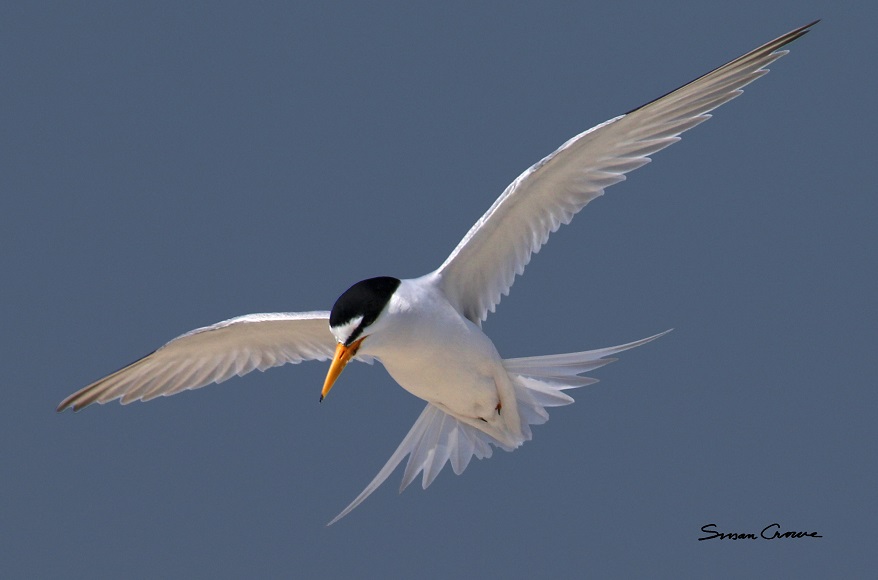
Least Tern in Adult plumage hovering in flight
The Atlantic Flyway, which in North America is the major migration path for all birds on the east coast extends from eastern Canada and Nova Scotia, down the coast thru New York and the New England states to the Gulf of Mexico and Florida. Year after year, during the fall migration, the parent birds guide their young down the coast on their first trip to the wintering areas in warmer climates. As spring approaches, they make their way back up the coast into our area and beyond to again rebuild their nests and raise their young during the summer months. Our coastal meadows and beach lines fill with the sound of Laughing Gulls, the chirps of the Osprey and the squawks of Herons during the summer. Our southern NJ meadows are unique and the coastal meadows between Barnegat Bay to our north and Cape May to our south host the largest concentration of nesting osprey and black skimmers of anywhere along the flyway. The state of NJ, with the help of many volunteers, has gone to great lengths installing wooden nesting platforms for the Ospreys and protecting beaches from human disturbance for the beach nesters during their nesting season. Although these nesting areas are protected by law, a pair of binoculars can easily bring them into our view.
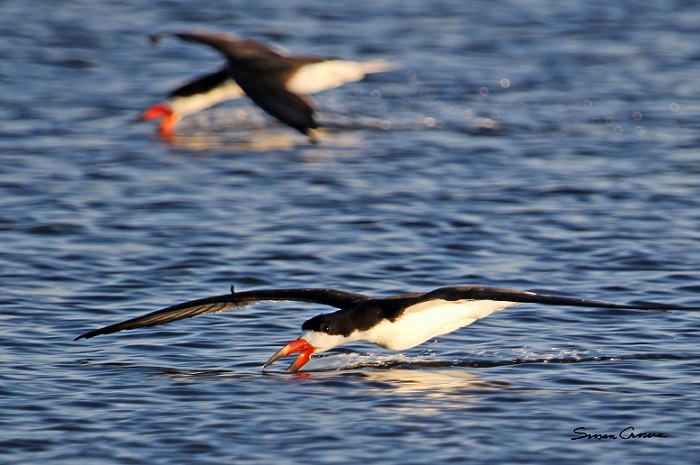
Black Skimmers - A very pretty and graceful bird in flight, they lower their bottom jaw into the water and skim the surface for small fish. https://susancrowephoto.smugmug.com/
For my wife and I today, as well as the many others we saw along our walk across the bridge and back, this has been a good adventure. My hat is off to the state of New Jersey and the cities of Somers Point and Ocean City for the recent bridge replacement that offers so much outdoor activity for visitors and residents of all ages. Whether you’re walking or riding a bike, fishing with the family, photographing wildlife or quietly enjoying the view of the sunrise or sunset, some time spent here is truly worth it. The exercise alone made this a worthy walk and along with the bird life and history that is here on the Howard S. Stainton Causeway has made this a day we will remember. There are outdoor lavatories placed near the fishing piers in the center of the span, as well as indoor facilities at the visitors center during their hours of operation. The fishing piers have ample parking and a stop at the visitors center is surely worth it. The gentleman at the counter of the center was courteous and helpful in answering the questions we had and directed us to the various attractions and attributes of the Howard S. Stainton Causeway and the local area.
To further enhance our experience today, we stepped into a small boat to explore the area around the bridge and islands from the water. Setting out two hours before high tide and returning two hours after, we spent our time slowly moving about and around the islands we had seen from the visitors center. We didn’t just see some birds, we saw lots and lots of birds. I was amazed to see how many Great Herons, Egrets, Herring Gulls, Laughing Gulls, Glossy Ibis, Oyster Catchers and Terns were using the islands.
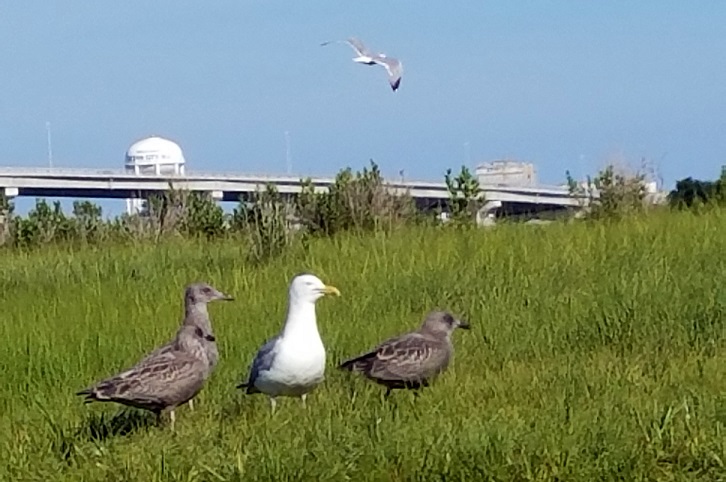
Herring Gull with young
With the bridge in the background, we sat and watched as young Herring Gulls along with an adult foraged around the edge of the water line. By now in mid July, they are completely feathered out and able to fly, but obviously did not want to be far from mom. The Laughing Gulls, which are only here in the summer, had many nests in the grasses and had many chicks. These chicks were still growing feathers and were still a week or two from being able to fly. Nesting on clumps of grass, the chicks are really good at hiding at first, but sitting quietly in the boat a little while, they relaxed and began to show themselves.
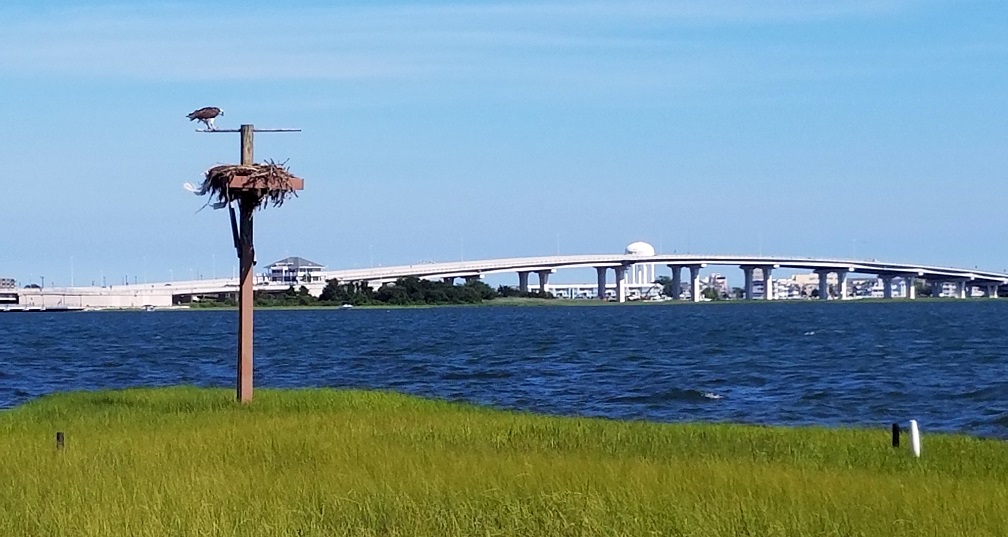
Osprey Platform overlooking Ninth Street Bridge
There are several wooden platforms built for the Osprey around the bridge and the platforms are abundant on our meadows. The Osprey return to our area each year around the third week of March and almost immediately reclaim their platform and the nest building begins. During April, eggs are laid and incubation begins and after 35-42 days the chicks hatch. During the summer almost every platform is occupied with this amazing fish hawk. The chicks will remain at the nest for about 55 days after hatching while they grow. Once their feathers are fully grown, they will leave or fledge the nest platform on their first flight and soon learn to soar with their parents. This is the time when they actually get to see how their parents have caught the food they have been eating. As summer progresses, the parent birds will begin to drop fish and force the young birds to dive for and catch fish. In a couple weeks the immature birds get the idea and start crashing the water’s surface like their parents. Keeping an ear tuned for their chirping sound during the later portion of summer, the families can be seen above Ocean City circling together while constantly calling to each other with their chirp,chirp,chirping. By the third week of September, their migration begins and they will follow their parents south down the flyway, to the finish their first year fishing in the warmth of the southeastern winters.
When on the ocean front, I look for the adult birds circling just beyond the breakers of the surf. Being able to see fish below the water’s surface, they begin their descent. As they near the water and if the fish they see stays at the surface, their wings fold back as they crash into the water feet first, to snag fish in their talons. Then with powerful wing beats, they lift themselves and the fish out of the water. After working to get high enough above the water they shake the excess water from their feathers and position their catch head first in their talons to reduce wind resistance and begin to climb above the buildings of town as they head back to the nest and share their catch with their mate and young. More often than not, when we see an Osprey flying inland from the ocean over the Ocean City Island, they are carrying fish, still flipping their tail as they try to wrestle free from the talons. It may seem easy for the Osprey, but many others birds such as crows, gulls and eagles become aware of the food they are carrying and will chase and harass the Osprey in a so-called dog-fight in hopes that the fish will be dropped. Many times we have watched Bald Eagles come out of what seems like nowhere in an attempt to steal the fish and should the Osprey drop it’s fish, the eagle will fold back their wings and dive or “stoop” on it, often times catching it before it hits the ground. In the same manner, I’ve seen fish dropped all the way to ground into yards, never to be recovered by the birds. Although the Osprey may lose occasionally to the harassers which seek to gain an easy meal, these aerial acrobatics are always awesome to watch.
As a child growing up here some 40 years ago, I can remember only two active nests. One was on an electric power pole west of the parkway bridge on the meadow between Marmora and Tuckahoe and the other on an Ocean Drive bill board at the north bound exit on the 34
th Street causeway in Marmora. In those days to see an Osprey while out fishing was rare and to see a Bald Eagle was unheard of. Both species ate fish and both species suffered a drastic population decline due to pollutants in the environment. But today this has turned around and the efforts of the NJ Endangered Species Program are very evident today. Through the dedicated work of the team of NJ biologists along with many volunteers and supporters, they studied and provided what was needed for the birds to make their comeback possible and long lasting. This next paragraph, posted on The Conserve Wildlife Foundation of NJ’s website, gives facts about Osprey population successes and links to help you explore this amazing coastal raptor, which exclusively survives on catching fish and calls our NJ coastal meadows home.
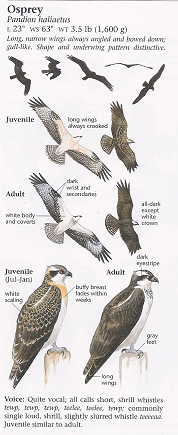
Sibley’s Guide to birds
Historically, before the effects of
DDT caused the state's osprey population to decline, over 500 osprey nests could be found along New Jersey's coastline. By 1974 only 50 nests remained. The effects of DDT in the food chain caused reproduction to fail, and
habitat was lost with a burgeoning shore population that eliminated many trees and increased ground
predator populations. In New Jersey the osprey was listed as endangered in 1974 by the state. Recovery began when DDT use was banned in 1968 in New Jersey. Biologists began to place young and eggs from nests where DDT was not used as heavily into nests that failed to produce young, year after year. Then they coordinated efforts to supply man-made nest platforms for the birds. These new artificial nest platforms replaced the snags and trees that were lost as the barrier islands became more developed. By 1986 the osprey population had surpassed 100 pairs, sparking the decision to upgrade their status to
threatened in the state. Since that time, the Endangered and Nongame Species Program staff has worked to monitor and manage the population, tracking their nest success every year with a core group of volunteers, and censusing the population every three years. In 2006 the NJ osprey population hit a new post-DDT record of just over 400 active nests, not far below the estimated historic population of 450 to 500 nests. In 2009, 486
nesting pairs were found. (Conserve Wildlife Foundation , NJ)
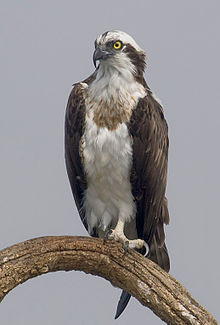
Conserve Wildlife Foundation of NJ
Turning our attention back to the bridge as we departed, I was reminded of what the Great Egg Harbor Bay must have looked like in the days the railroad built the first bridge. What the early tourists must have seen as they rode the train into town and how fortunate we are to be here today, in the sun and the water and amongst the birds of the Great Egg Harbor Bay and of the Atlantic Flyway. With some regret we left it behind, taking with us some great memories. We extend a hearty Thank you to local photographer Susan Crowe for her expertise with her camera and for sharing her local knowledge of our area. Susan, being a life long resident of Ocean City, spends much of her time capturing photos in and around the Ocean City area. She specializes in year round wildlife photography and her work can be viewed @
https://susancrowephoto.smugmug.com/
We will plan to return as summer progresses and again in the fall as migrations begin to move southward throughout the Atlantic Flyway. Thank you for coming along and we hope to see out there, with binoculars, learning about and enjoying this natural resource we know as home.
Paul
Editor’s note:
Paul and His wife are life long residents of the area and have spent much of their lives together exploring the natural areas of our southern New Jersey region. With a specialty in bird identification, migration patterns and nesting habits as well as numerous raptor programs and wildlife projects, they have spoken to thousands of residents and visitors about the valuable natural resources we have here in Southern New Jersey.
 For most of us who vacation in Ocean City, there is that time of packing the clothes, the beach gear and chairs, taking care of all the last minute details and jumping in the car. We are on our way, vacation is here, we are headed to the shore. If you are traveling on the weekend, the excitement of it all is soon muddied a bit as we come to a stop on the congested roadways and wait our turn to get through the snarls of traffic. For those who are headed to Cape May County, the Somers Point area, exit 30 of the Garden State Parkway must bring to them a somewhat euphoric state. The coastal meadows which the parkway winds through, brings the feel that life is slowing down. The worries and details which were so important yesterday fade from our memory and the sense of recreation and relaxation floods the mind. The coastal estuaries and open spaces let us know that we are getting close and the excitement of vacation rebuilds in us. The children stop asking if we are there yet and a peace and serenity enters in as we cross the bridge onto the barrier islands. With all the business behind us, we settle in and think of the beach, the surf and the boardwalk. We may not think much of the bridge we crossed to be here until we leave, but as important as the sand, sun and water is to Ocean City, likewise, so is the bridge that bought us here.
For most of us who vacation in Ocean City, there is that time of packing the clothes, the beach gear and chairs, taking care of all the last minute details and jumping in the car. We are on our way, vacation is here, we are headed to the shore. If you are traveling on the weekend, the excitement of it all is soon muddied a bit as we come to a stop on the congested roadways and wait our turn to get through the snarls of traffic. For those who are headed to Cape May County, the Somers Point area, exit 30 of the Garden State Parkway must bring to them a somewhat euphoric state. The coastal meadows which the parkway winds through, brings the feel that life is slowing down. The worries and details which were so important yesterday fade from our memory and the sense of recreation and relaxation floods the mind. The coastal estuaries and open spaces let us know that we are getting close and the excitement of vacation rebuilds in us. The children stop asking if we are there yet and a peace and serenity enters in as we cross the bridge onto the barrier islands. With all the business behind us, we settle in and think of the beach, the surf and the boardwalk. We may not think much of the bridge we crossed to be here until we leave, but as important as the sand, sun and water is to Ocean City, likewise, so is the bridge that bought us here.
 Today my wife and I have decided to explore the Howard S. Stainton Causeway, Route 52 and locally known as the Ninth Street Bridge. At first glance we may not realize the natural value of it, but turning our focus away from the concrete and traffic, we see a vast natural area within the back bay region which holds the habitat for all the different species of plant, fish, shellfish and wildlife that depend on it for feeding, nesting and life in general. Situated along the Atlantic Flyway, the bicycle and pedestrian walkway along the bridge offers us 2.2 miles one way of access and viewing of the Great Egg Harbor Bay. On the Somers Point end there is Ship’s Channel which connects the Atlantic Ocean to the Great Egg Harbor River, and leads 10 miles inland to Mays Landing. On the Ocean City end there is the Intracoastal Waterway which runs along the western side of Ocean City. Parking our car at the Visitors center, we grab our binoculars and climb the steps to the second floor deck which surrounds the building. Situated along the deck railings are numerous informational plaques which tell the history of the bridge, the various wildlife which visits the area, as well some of the history of early Ocean City. The history of the railroads which first brought tourists to the shore along with the beginning of automobile traffic across the first wooden timber bridge is very interesting and brings to mind how much has happened in 100 and some years. Moving on around to the south side we see the information plaque about the wildlife which frequents the area. With binoculars in hand, we notice the presence of the various birds that live here in the summer months. Notably and very worthy of mention is a rookery of nesting Night Herons and Glossy Ibis in front of us among the cedar trees, which was preserved during the reconstruction giving us a tremendous opportunity to see and photograph these birds as they raise their young. Beyond that and across a small creek, is Cowpens Island and some other relatively small islands which are all home to the nesting Gulls, Ibis, Egrets and Herons. With all the different birds here in summer, knowing what you are seeing can be confusing. By far the best way to learn is to stand beside someone knowledgeable who can show and explain you the markings, shapes, behaviors and characteristics of the different birds. If you consider yourself a novice, a good field guide and binoculars are very useful tools. Above the trees, the Terns, Herons, Ibis, Skimmers, Ospreys, and of course the different Gulls all shape the sky with their constant flight. With the sounds of the seagulls and the smell of the seashore in the air, we are reminded again that we are here in Ocean City, along the coast, and in the Atlantic Flyway.
Today my wife and I have decided to explore the Howard S. Stainton Causeway, Route 52 and locally known as the Ninth Street Bridge. At first glance we may not realize the natural value of it, but turning our focus away from the concrete and traffic, we see a vast natural area within the back bay region which holds the habitat for all the different species of plant, fish, shellfish and wildlife that depend on it for feeding, nesting and life in general. Situated along the Atlantic Flyway, the bicycle and pedestrian walkway along the bridge offers us 2.2 miles one way of access and viewing of the Great Egg Harbor Bay. On the Somers Point end there is Ship’s Channel which connects the Atlantic Ocean to the Great Egg Harbor River, and leads 10 miles inland to Mays Landing. On the Ocean City end there is the Intracoastal Waterway which runs along the western side of Ocean City. Parking our car at the Visitors center, we grab our binoculars and climb the steps to the second floor deck which surrounds the building. Situated along the deck railings are numerous informational plaques which tell the history of the bridge, the various wildlife which visits the area, as well some of the history of early Ocean City. The history of the railroads which first brought tourists to the shore along with the beginning of automobile traffic across the first wooden timber bridge is very interesting and brings to mind how much has happened in 100 and some years. Moving on around to the south side we see the information plaque about the wildlife which frequents the area. With binoculars in hand, we notice the presence of the various birds that live here in the summer months. Notably and very worthy of mention is a rookery of nesting Night Herons and Glossy Ibis in front of us among the cedar trees, which was preserved during the reconstruction giving us a tremendous opportunity to see and photograph these birds as they raise their young. Beyond that and across a small creek, is Cowpens Island and some other relatively small islands which are all home to the nesting Gulls, Ibis, Egrets and Herons. With all the different birds here in summer, knowing what you are seeing can be confusing. By far the best way to learn is to stand beside someone knowledgeable who can show and explain you the markings, shapes, behaviors and characteristics of the different birds. If you consider yourself a novice, a good field guide and binoculars are very useful tools. Above the trees, the Terns, Herons, Ibis, Skimmers, Ospreys, and of course the different Gulls all shape the sky with their constant flight. With the sounds of the seagulls and the smell of the seashore in the air, we are reminded again that we are here in Ocean City, along the coast, and in the Atlantic Flyway.
 Least Tern in Adult plumage hovering in flight
The Atlantic Flyway, which in North America is the major migration path for all birds on the east coast extends from eastern Canada and Nova Scotia, down the coast thru New York and the New England states to the Gulf of Mexico and Florida. Year after year, during the fall migration, the parent birds guide their young down the coast on their first trip to the wintering areas in warmer climates. As spring approaches, they make their way back up the coast into our area and beyond to again rebuild their nests and raise their young during the summer months. Our coastal meadows and beach lines fill with the sound of Laughing Gulls, the chirps of the Osprey and the squawks of Herons during the summer. Our southern NJ meadows are unique and the coastal meadows between Barnegat Bay to our north and Cape May to our south host the largest concentration of nesting osprey and black skimmers of anywhere along the flyway. The state of NJ, with the help of many volunteers, has gone to great lengths installing wooden nesting platforms for the Ospreys and protecting beaches from human disturbance for the beach nesters during their nesting season. Although these nesting areas are protected by law, a pair of binoculars can easily bring them into our view.
Least Tern in Adult plumage hovering in flight
The Atlantic Flyway, which in North America is the major migration path for all birds on the east coast extends from eastern Canada and Nova Scotia, down the coast thru New York and the New England states to the Gulf of Mexico and Florida. Year after year, during the fall migration, the parent birds guide their young down the coast on their first trip to the wintering areas in warmer climates. As spring approaches, they make their way back up the coast into our area and beyond to again rebuild their nests and raise their young during the summer months. Our coastal meadows and beach lines fill with the sound of Laughing Gulls, the chirps of the Osprey and the squawks of Herons during the summer. Our southern NJ meadows are unique and the coastal meadows between Barnegat Bay to our north and Cape May to our south host the largest concentration of nesting osprey and black skimmers of anywhere along the flyway. The state of NJ, with the help of many volunteers, has gone to great lengths installing wooden nesting platforms for the Ospreys and protecting beaches from human disturbance for the beach nesters during their nesting season. Although these nesting areas are protected by law, a pair of binoculars can easily bring them into our view.
 Black Skimmers - A very pretty and graceful bird in flight, they lower their bottom jaw into the water and skim the surface for small fish. https://susancrowephoto.smugmug.com/
For my wife and I today, as well as the many others we saw along our walk across the bridge and back, this has been a good adventure. My hat is off to the state of New Jersey and the cities of Somers Point and Ocean City for the recent bridge replacement that offers so much outdoor activity for visitors and residents of all ages. Whether you’re walking or riding a bike, fishing with the family, photographing wildlife or quietly enjoying the view of the sunrise or sunset, some time spent here is truly worth it. The exercise alone made this a worthy walk and along with the bird life and history that is here on the Howard S. Stainton Causeway has made this a day we will remember. There are outdoor lavatories placed near the fishing piers in the center of the span, as well as indoor facilities at the visitors center during their hours of operation. The fishing piers have ample parking and a stop at the visitors center is surely worth it. The gentleman at the counter of the center was courteous and helpful in answering the questions we had and directed us to the various attractions and attributes of the Howard S. Stainton Causeway and the local area.
To further enhance our experience today, we stepped into a small boat to explore the area around the bridge and islands from the water. Setting out two hours before high tide and returning two hours after, we spent our time slowly moving about and around the islands we had seen from the visitors center. We didn’t just see some birds, we saw lots and lots of birds. I was amazed to see how many Great Herons, Egrets, Herring Gulls, Laughing Gulls, Glossy Ibis, Oyster Catchers and Terns were using the islands.
Black Skimmers - A very pretty and graceful bird in flight, they lower their bottom jaw into the water and skim the surface for small fish. https://susancrowephoto.smugmug.com/
For my wife and I today, as well as the many others we saw along our walk across the bridge and back, this has been a good adventure. My hat is off to the state of New Jersey and the cities of Somers Point and Ocean City for the recent bridge replacement that offers so much outdoor activity for visitors and residents of all ages. Whether you’re walking or riding a bike, fishing with the family, photographing wildlife or quietly enjoying the view of the sunrise or sunset, some time spent here is truly worth it. The exercise alone made this a worthy walk and along with the bird life and history that is here on the Howard S. Stainton Causeway has made this a day we will remember. There are outdoor lavatories placed near the fishing piers in the center of the span, as well as indoor facilities at the visitors center during their hours of operation. The fishing piers have ample parking and a stop at the visitors center is surely worth it. The gentleman at the counter of the center was courteous and helpful in answering the questions we had and directed us to the various attractions and attributes of the Howard S. Stainton Causeway and the local area.
To further enhance our experience today, we stepped into a small boat to explore the area around the bridge and islands from the water. Setting out two hours before high tide and returning two hours after, we spent our time slowly moving about and around the islands we had seen from the visitors center. We didn’t just see some birds, we saw lots and lots of birds. I was amazed to see how many Great Herons, Egrets, Herring Gulls, Laughing Gulls, Glossy Ibis, Oyster Catchers and Terns were using the islands.
 Herring Gull with young
With the bridge in the background, we sat and watched as young Herring Gulls along with an adult foraged around the edge of the water line. By now in mid July, they are completely feathered out and able to fly, but obviously did not want to be far from mom. The Laughing Gulls, which are only here in the summer, had many nests in the grasses and had many chicks. These chicks were still growing feathers and were still a week or two from being able to fly. Nesting on clumps of grass, the chicks are really good at hiding at first, but sitting quietly in the boat a little while, they relaxed and began to show themselves.
Herring Gull with young
With the bridge in the background, we sat and watched as young Herring Gulls along with an adult foraged around the edge of the water line. By now in mid July, they are completely feathered out and able to fly, but obviously did not want to be far from mom. The Laughing Gulls, which are only here in the summer, had many nests in the grasses and had many chicks. These chicks were still growing feathers and were still a week or two from being able to fly. Nesting on clumps of grass, the chicks are really good at hiding at first, but sitting quietly in the boat a little while, they relaxed and began to show themselves.
 Osprey Platform overlooking Ninth Street Bridge
There are several wooden platforms built for the Osprey around the bridge and the platforms are abundant on our meadows. The Osprey return to our area each year around the third week of March and almost immediately reclaim their platform and the nest building begins. During April, eggs are laid and incubation begins and after 35-42 days the chicks hatch. During the summer almost every platform is occupied with this amazing fish hawk. The chicks will remain at the nest for about 55 days after hatching while they grow. Once their feathers are fully grown, they will leave or fledge the nest platform on their first flight and soon learn to soar with their parents. This is the time when they actually get to see how their parents have caught the food they have been eating. As summer progresses, the parent birds will begin to drop fish and force the young birds to dive for and catch fish. In a couple weeks the immature birds get the idea and start crashing the water’s surface like their parents. Keeping an ear tuned for their chirping sound during the later portion of summer, the families can be seen above Ocean City circling together while constantly calling to each other with their chirp,chirp,chirping. By the third week of September, their migration begins and they will follow their parents south down the flyway, to the finish their first year fishing in the warmth of the southeastern winters.
When on the ocean front, I look for the adult birds circling just beyond the breakers of the surf. Being able to see fish below the water’s surface, they begin their descent. As they near the water and if the fish they see stays at the surface, their wings fold back as they crash into the water feet first, to snag fish in their talons. Then with powerful wing beats, they lift themselves and the fish out of the water. After working to get high enough above the water they shake the excess water from their feathers and position their catch head first in their talons to reduce wind resistance and begin to climb above the buildings of town as they head back to the nest and share their catch with their mate and young. More often than not, when we see an Osprey flying inland from the ocean over the Ocean City Island, they are carrying fish, still flipping their tail as they try to wrestle free from the talons. It may seem easy for the Osprey, but many others birds such as crows, gulls and eagles become aware of the food they are carrying and will chase and harass the Osprey in a so-called dog-fight in hopes that the fish will be dropped. Many times we have watched Bald Eagles come out of what seems like nowhere in an attempt to steal the fish and should the Osprey drop it’s fish, the eagle will fold back their wings and dive or “stoop” on it, often times catching it before it hits the ground. In the same manner, I’ve seen fish dropped all the way to ground into yards, never to be recovered by the birds. Although the Osprey may lose occasionally to the harassers which seek to gain an easy meal, these aerial acrobatics are always awesome to watch.
As a child growing up here some 40 years ago, I can remember only two active nests. One was on an electric power pole west of the parkway bridge on the meadow between Marmora and Tuckahoe and the other on an Ocean Drive bill board at the north bound exit on the 34th Street causeway in Marmora. In those days to see an Osprey while out fishing was rare and to see a Bald Eagle was unheard of. Both species ate fish and both species suffered a drastic population decline due to pollutants in the environment. But today this has turned around and the efforts of the NJ Endangered Species Program are very evident today. Through the dedicated work of the team of NJ biologists along with many volunteers and supporters, they studied and provided what was needed for the birds to make their comeback possible and long lasting. This next paragraph, posted on The Conserve Wildlife Foundation of NJ’s website, gives facts about Osprey population successes and links to help you explore this amazing coastal raptor, which exclusively survives on catching fish and calls our NJ coastal meadows home.
Osprey Platform overlooking Ninth Street Bridge
There are several wooden platforms built for the Osprey around the bridge and the platforms are abundant on our meadows. The Osprey return to our area each year around the third week of March and almost immediately reclaim their platform and the nest building begins. During April, eggs are laid and incubation begins and after 35-42 days the chicks hatch. During the summer almost every platform is occupied with this amazing fish hawk. The chicks will remain at the nest for about 55 days after hatching while they grow. Once their feathers are fully grown, they will leave or fledge the nest platform on their first flight and soon learn to soar with their parents. This is the time when they actually get to see how their parents have caught the food they have been eating. As summer progresses, the parent birds will begin to drop fish and force the young birds to dive for and catch fish. In a couple weeks the immature birds get the idea and start crashing the water’s surface like their parents. Keeping an ear tuned for their chirping sound during the later portion of summer, the families can be seen above Ocean City circling together while constantly calling to each other with their chirp,chirp,chirping. By the third week of September, their migration begins and they will follow their parents south down the flyway, to the finish their first year fishing in the warmth of the southeastern winters.
When on the ocean front, I look for the adult birds circling just beyond the breakers of the surf. Being able to see fish below the water’s surface, they begin their descent. As they near the water and if the fish they see stays at the surface, their wings fold back as they crash into the water feet first, to snag fish in their talons. Then with powerful wing beats, they lift themselves and the fish out of the water. After working to get high enough above the water they shake the excess water from their feathers and position their catch head first in their talons to reduce wind resistance and begin to climb above the buildings of town as they head back to the nest and share their catch with their mate and young. More often than not, when we see an Osprey flying inland from the ocean over the Ocean City Island, they are carrying fish, still flipping their tail as they try to wrestle free from the talons. It may seem easy for the Osprey, but many others birds such as crows, gulls and eagles become aware of the food they are carrying and will chase and harass the Osprey in a so-called dog-fight in hopes that the fish will be dropped. Many times we have watched Bald Eagles come out of what seems like nowhere in an attempt to steal the fish and should the Osprey drop it’s fish, the eagle will fold back their wings and dive or “stoop” on it, often times catching it before it hits the ground. In the same manner, I’ve seen fish dropped all the way to ground into yards, never to be recovered by the birds. Although the Osprey may lose occasionally to the harassers which seek to gain an easy meal, these aerial acrobatics are always awesome to watch.
As a child growing up here some 40 years ago, I can remember only two active nests. One was on an electric power pole west of the parkway bridge on the meadow between Marmora and Tuckahoe and the other on an Ocean Drive bill board at the north bound exit on the 34th Street causeway in Marmora. In those days to see an Osprey while out fishing was rare and to see a Bald Eagle was unheard of. Both species ate fish and both species suffered a drastic population decline due to pollutants in the environment. But today this has turned around and the efforts of the NJ Endangered Species Program are very evident today. Through the dedicated work of the team of NJ biologists along with many volunteers and supporters, they studied and provided what was needed for the birds to make their comeback possible and long lasting. This next paragraph, posted on The Conserve Wildlife Foundation of NJ’s website, gives facts about Osprey population successes and links to help you explore this amazing coastal raptor, which exclusively survives on catching fish and calls our NJ coastal meadows home.

 Conserve Wildlife Foundation of NJ
Turning our attention back to the bridge as we departed, I was reminded of what the Great Egg Harbor Bay must have looked like in the days the railroad built the first bridge. What the early tourists must have seen as they rode the train into town and how fortunate we are to be here today, in the sun and the water and amongst the birds of the Great Egg Harbor Bay and of the Atlantic Flyway. With some regret we left it behind, taking with us some great memories. We extend a hearty Thank you to local photographer Susan Crowe for her expertise with her camera and for sharing her local knowledge of our area. Susan, being a life long resident of Ocean City, spends much of her time capturing photos in and around the Ocean City area. She specializes in year round wildlife photography and her work can be viewed @ https://susancrowephoto.smugmug.com/
We will plan to return as summer progresses and again in the fall as migrations begin to move southward throughout the Atlantic Flyway. Thank you for coming along and we hope to see out there, with binoculars, learning about and enjoying this natural resource we know as home.
Paul
Editor’s note:
Paul and His wife are life long residents of the area and have spent much of their lives together exploring the natural areas of our southern New Jersey region. With a specialty in bird identification, migration patterns and nesting habits as well as numerous raptor programs and wildlife projects, they have spoken to thousands of residents and visitors about the valuable natural resources we have here in Southern New Jersey.
Conserve Wildlife Foundation of NJ
Turning our attention back to the bridge as we departed, I was reminded of what the Great Egg Harbor Bay must have looked like in the days the railroad built the first bridge. What the early tourists must have seen as they rode the train into town and how fortunate we are to be here today, in the sun and the water and amongst the birds of the Great Egg Harbor Bay and of the Atlantic Flyway. With some regret we left it behind, taking with us some great memories. We extend a hearty Thank you to local photographer Susan Crowe for her expertise with her camera and for sharing her local knowledge of our area. Susan, being a life long resident of Ocean City, spends much of her time capturing photos in and around the Ocean City area. She specializes in year round wildlife photography and her work can be viewed @ https://susancrowephoto.smugmug.com/
We will plan to return as summer progresses and again in the fall as migrations begin to move southward throughout the Atlantic Flyway. Thank you for coming along and we hope to see out there, with binoculars, learning about and enjoying this natural resource we know as home.
Paul
Editor’s note:
Paul and His wife are life long residents of the area and have spent much of their lives together exploring the natural areas of our southern New Jersey region. With a specialty in bird identification, migration patterns and nesting habits as well as numerous raptor programs and wildlife projects, they have spoken to thousands of residents and visitors about the valuable natural resources we have here in Southern New Jersey.